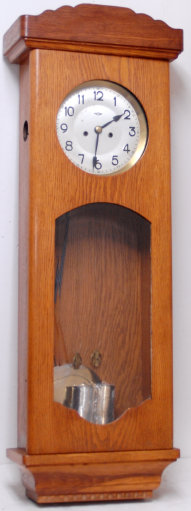
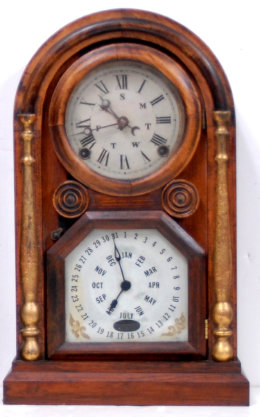
44. $500
Welch, Spring & Co. “Italian No. 3” calendar clock, ca 1868.
The label inside the case is all in place and designates Welch, Spring as the manufacturer and seller, however it was actually made
by the B.B. Lewis Clock Co. between 1868 and 1870. When B. B. Lewis went to work for Welch, Spring, his clocks were added to the Welch
line. The complete black and gold label over the calendar movement (back side of the door) indicates the calendar was patented by
B.B. Lewis but manufactured by Welch, Spring. The just under 19-inch-high rosewood veneered case is near perfect, but as usual has
some tiny chips along the base. Door latches, glasses, gong, brass bob, hands, and both dials are original to the case. There are
some small insignificant paint bubbles on the upper dial. The movement is 8-day, running, and striking the coil gong on the hours.
As far as I can tell from my prior sales of this model and sales at distant auction houses, the style and height of the model varies,
not all are the same. Ly-Welch, page 78. $500-$750.

45. $500
Ansonia Clock Co. uncommon hanging black walnut cased clock, “Forrest”,
ca 1904. It is not a small clock for it is 41” high, has a good look with lots of applied ornaments, many that are carved, grooved,
and etched with various designs. It has the original crazed finish, slightly dark but not smoke covered and was lightly cleaned with
polish. All the wood parts on the clock are original as is the glass, dial, and hands. Inside, the brass bob, wood stick, brass dial
rings, cathedral gong, and 8-day brass movement, are all original to the case. The label inside the case is perfect. We have very
seldom seen this model, and never with all the original wood ornaments. For some reason this model has always had a high book value,
over $800. Ly-Ansonia #615. $500-$750.
43. $500
“Welch, Spring & Co.” Italian No. 2, calendar clock, ca 1872. In 45 years I have not had any of this model and cannot find
any sales at any of the live auction companies. The rosewood shelf clock is 16” high and in original condition. The case for its age
is excellent. There are no breaks or repairs, it has an old good original finish, and perhaps an edge nick. The dial, hands, and glasses,
are all original. The calendar dials are original and for their age in remarkably good condition. Complete paper label inside and
about half of a label on the back. The coil gong, old brass bob, and the eight-day movement that is signed, all appear to be original.
The movement is complete and operational, striking hours on the coil gong. The clock was originally sold by Welch, Spring & Co,
but was actually manufactured by the B. B. Lewis Clock Co. between 1868 and 1870. This is noted by the peep hole in the lower calendar
dial and the straight mitered base. When Lewis went to work for Welch, Spring he sold them his surplus No. 2 mantel clocks. There
is more information about this clock in Ly-Welch, page 77. $1500-$750.
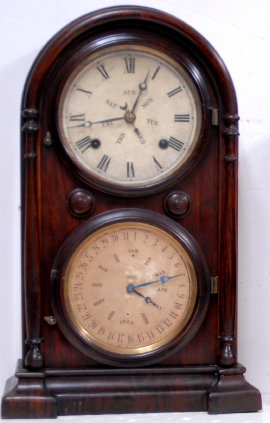
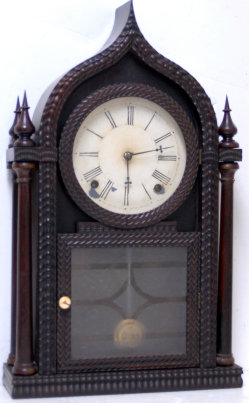
46. $800
“Forestville Manufacturing Company, / J. C. Brown, Bristol, Conn.”, 4 column onion top or sharp gothic clock, ca 1848. Rosewood veneered case is 20 inches tall and has all its original wood and internal parts. The clock has not had any veneer restorations or repairs. You would have to look long and hard to find any case problems. Even the finial tips are perfect and it has Brown’s patent bone door knob. The glasses are good and I believe the bottom glass is original. It has a complete label and an original painted dial, and old pendulum bob and coil gong. You can never be sure about the hands. The dial is not bad considering its age, and has some small paint chips, all are around the screws and winding arbors. The 8-day brass movement is running and signed by the maker. We see this style clock, without fusees, sell for $3000 and more at eastern auctions. The last one I saw was last fall and it went for $2300 plus some fees charged by the company that monitored the auction on line. This clock is all original and a very nice example of this model. $1000-$1500.
42. $200
Kienzle/German Vienna two weight regulator, ca 1929. The company
was founded in 1787 and passed down thru the family and still in operation today. The 39-inch-high oak case is exceptionally nice,
clean, and polished. It has beveled glass in the lower part of the door, a flat glass over the dial, and small round glasses on the
sides. The dial, pendulum bob, beat scale and weights are all nickeled while the dial surround and pulleys are brass. The 8-day movement
is running and it strikes three chime rods. The wall levelers on this clock are inside the case and easily turned to level the clock.
Excellent clock for this minimum. $250-$400.

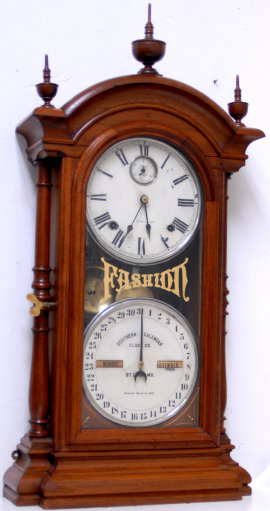
47. $1100
Southern Calendar Clock Co. “Fashion No. 4”, ca 1880. The Culver
brothers started this company in 1875 and the best marketing decision they made was to contract with the Seth Thomas Clock Co. for
the running and calendar movements for the Fashions. Most experts agree that the movements used in the Fashion clocks were the finest
Seth Thomas ever made. The clock is running and keeping time as designed. The four hands, upper and lower dial, nickeled bezels, calendar
rollers, and Fashion glass, are all original and correct. The pendulum rod has had a piece of reinforcement metal added but you cannot
see that in the clock. It is very unusual that these original dials have only some minor paint chips. Usually by now both dials would
have been so bad they had to be repainted. The walnut case is 32” high, complete and original. All three finials have good tips and
we cannot verify if there are factory lathe marks on the ends because they are glued into the case. There is a complete black label
inside; the movements are clean, signed, and running. Overall a good example of the No. 4. Ly-Calendar, page 286. $1200-$1500.
48. $1000
Ithaca Calendar Clock Co. “No. 2 Regulator, Or Hanging Bank Clock”,
ca 1874. The early regulators “O”, “1”, and “2”, were very similar in case design but the movements were different. The No. 2 case
is made of walnut and is 48” high, glass port on the bottom, large finial on top. This clock is not perfect by any means but for its
age it is still ticking. The paper dials certainly appear to be original but new ones are so readily available you can never tell
for sure. The bottom paper dial has a tear repair and slightly darkened. The time dial is not as nice as the calendar dial,
lots of repairs but the consignor chose to have original dials rather than new white dials. The upper movement is 8-day and powered
by two long wafer type weights. The perpetual calendar movement was invented by Henry Horton, the founder of the Ithaca Calendar Clock
Co. There is one door lock operated with the winding key. Present are all the accessory parts, the two original weights, brass pendulum
bob, three hands, calendar rollers, ands both paper dials. Ly-Calendar #294. $1000-$1500.

50. $500
“Waltham Watch & Clock Co.” ca 1930 banjo clock. This clock
uses Waltham’s famous 8-day timepiece weight driven movement that is signed and numbered. The original internal parts are the movement,
pendulum, pendulum stick, weight chute metal cover, lead weight, and winding key. It is missing the original tie down bar but our
collector made his own. The throat glass and bottom Mt. Vernon glass have a few minor paint chips that have been spot covered. There
is a gilt rope around both painted glasses and gilt covered balls on the base. The dial is original, signature is good, hands are
original, and the two door latches are in good working order. Mahogany case has the original finish, stands near 41” high, and retains
the original brass eagle, brass side rails, and brass sash holding the bowed glass. This style Waltham banjo clock regularly sells
everywhere, in the $1000-$2000 range. Ly-American, page 248. $600-$900.
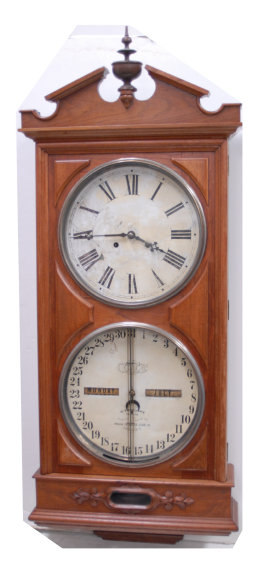

51. $500
Waltham Clock Co., Waltham, Mass. 8-day time only weight driven
movement, ca 1930. In a mahogany case 42 inches high, 10.5 inches wide and with reverse painted tablets that have slight paint flaking.
The mahogany case is very nice as is the painted metal dial. The hands, eagle on top, brass side rails, brass pendulum bob and wood
stick, the iron weight and pulley are all correct. The weight chute at the bottom has the typical metal covering and pendulum tie
down arrangement. The individual case parts are stamped, “7”. The dial is signed “Waltham”. The 8-day movement is signed, running
and original to the case. The stylish case is plain in that there is no gold paint, etc. but does have the balls around the base.
Ly-American Clocks, Volume 1, pages 246-247. This clock has always booked around $2500 but in recent years retails for a little less.
$600-$900.
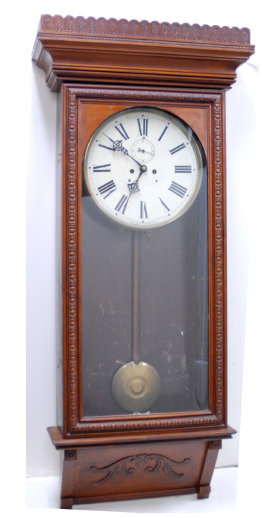
52. $500
Waterbury Clock Company, “Regulator No. 67”, ca 1906. Dark oak
case is 50” tall, retaining the original finish, dark with smoke accumulation, but is clean. There are pressed designs on the top
rail, ripple molding below that, and several layers of other molding. The large door has ripple molding all around. There are two
door hooks and a large glass. We cannot say for sure the glass is original. The base has applied wood ornaments. The signed dial is
holding its original paint with light touchup around the three screw holes. The brass bob, wood stick, signed porcelain beat scale,
and brass pulleys, are all original. It has a complete label on the inside bottom of the case. The 8-day time only movement is running.
The iron weights are coated with varnish making it impossible to tell if they have imitation graining underneath the varnish. The
only demerit is scuff marks on the backboard where the pendulum banged around during hauling. Ly-Waterbury #573. $650-$900.